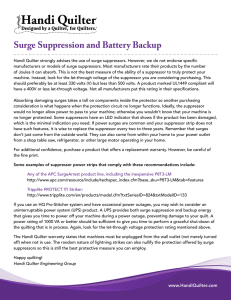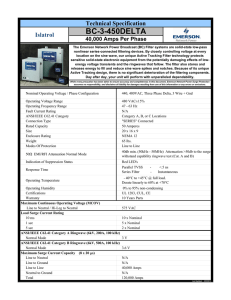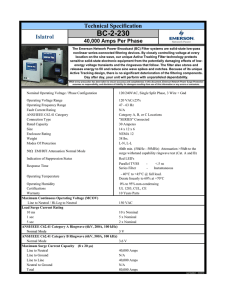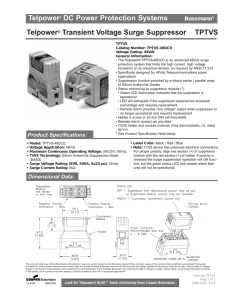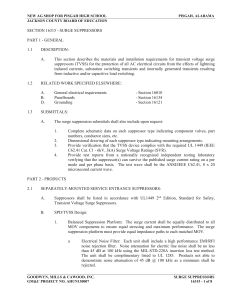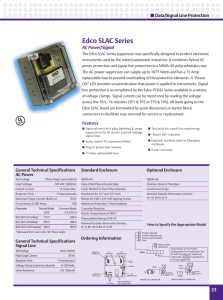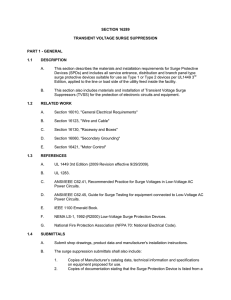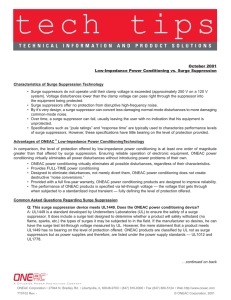SECTION 16315
advertisement
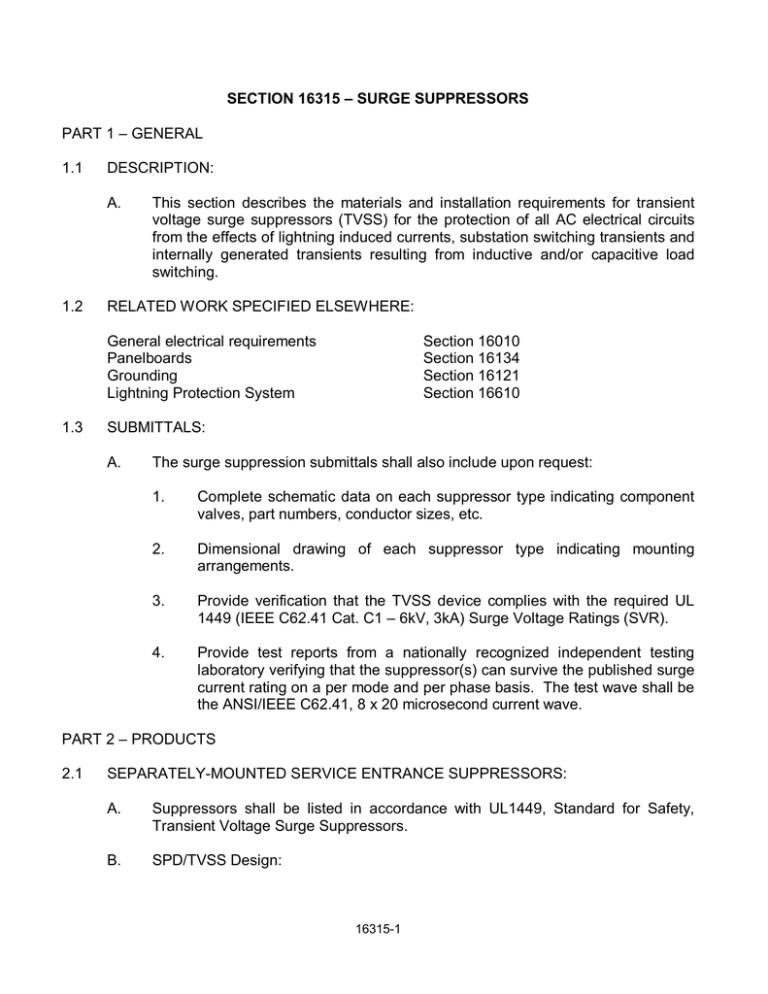
SECTION 16315 – SURGE SUPPRESSORS PART 1 – GENERAL 1.1 DESCRIPTION: A. 1.2 This section describes the materials and installation requirements for transient voltage surge suppressors (TVSS) for the protection of all AC electrical circuits from the effects of lightning induced currents, substation switching transients and internally generated transients resulting from inductive and/or capacitive load switching. RELATED WORK SPECIFIED ELSEWHERE: General electrical requirements Panelboards Grounding Lightning Protection System 1.3 Section 16010 Section 16134 Section 16121 Section 16610 SUBMITTALS: A. The surge suppression submittals shall also include upon request: 1. Complete schematic data on each suppressor type indicating component valves, part numbers, conductor sizes, etc. 2. Dimensional drawing of each suppressor type indicating mounting arrangements. 3. Provide verification that the TVSS device complies with the required UL 1449 (IEEE C62.41 Cat. C1 – 6kV, 3kA) Surge Voltage Ratings (SVR). 4. Provide test reports from a nationally recognized independent testing laboratory verifying that the suppressor(s) can survive the published surge current rating on a per mode and per phase basis. The test wave shall be the ANSI/IEEE C62.41, 8 x 20 microsecond current wave. PART 2 – PRODUCTS 2.1 SEPARATELY-MOUNTED SERVICE ENTRANCE SUPPRESSORS: A. Suppressors shall be listed in accordance with UL1449, Standard for Safety, Transient Voltage Surge Suppressors. B. SPD/TVSS Design: 16315-1 C. 1. Balanced Suppression Platform: The surge current shall be equally distributed to all MOV components to ensure equal stressing and maximum performance. The surge suppression platform must provide equal impedance paths to each matched MOV. 2. Electrical Noise Filter: Each unit shall include a high performance EM/RFI noise rejection filter. Noise attenuation for electric line noise shall be no less than 45 dB at 100 kHz using the MIL-STD-220A insertion loss test method. The unit shall be complimentary listed to UL 1283. Products not able to demonstrate noise attenuation of 45 dB @ 100 kHz as a minimum shall be rejected. 3. Internal Connections: All internal components shall be hardwired with connections utilizing low impedance conductors and compression fittings. Suppressors shall meet or exceed the following criteria: 1. Maximum single impulse current rating (per phase): 250,000 amperes (8 x 20 us – waveform). 2. Maximum single impulse current rating (per mode): 250,000 amperes (8 x 20 us – waveform). 3. Maximum Continuous Operating Voltage (MCOV): The MCOV shall be greater than 115% of the nominal system operating voltage. 4. Protection Modes: For a Wye configured system, the device must have directly connected suppression elements between line-line (L-L), lineneutral (L-N), line-ground (L-G), and neutral-ground (N-G). For a Delta configured system, the device must have suppression elements between line-to-line (L-L) and line-to-ground (L-G). 5. UL 1449 SVR: The maximum UL 1449 (IEEE C62.41 Cat. C1 6kV, 3kA) SVR for the device must not exceed the following: Modes WYE-L-N; L-G; N-G 6. 208Y/120 400 V 480Y/277 800 V ANSI/IEEE Cat. C3 Let Through Voltage: The let through voltage based on ANSI/IEEE C62.41 and C62.45 recommended procedures for Cat. C3 surges (20 kV, 10kA) shall be less than: Modes L–N 208Y/120 500 V 16315-2 480Y/277 900 V 7. ANSI/IEEE Cat. B3 Let Through Voltage: Let Through voltage based on ANSI/IEEE C62.41 and C62.45 recommended procedures for the ANSI/IEEE Cat. B3 Ringwave (6 kV, 5000 amps) shall be less than: Modes L–N D. 2.2 208Y/120 170 V 480Y/277 300 V Accessories: 1. Transient event counter with audible alarm and LED indicators. 2. Remote Status Monitor: Form C dry contacts (one (1) N.O. and one (1) N.C.) for remote annunciation of unit status: the remote alarm shall change state if any of the three (3) monitoring systems described detect a fault condition. 3. Push-To-Test Feature: Incorporate an integral test feature, which verifies the operational integrity of the unit’s monitoring system. PANELBOARDS & SWITCHBOARD-MOUNTED SUPPRESSORS: A. Panelboard shall be UL 1449 listed and CSA 22.2 certified approved as a transient voltage surge suppressor. 1. The panelboard SPD/TVSS shall be tested and suitable for ANSI/IEEE C62.41 Cat. C1 (6kV, 3kA) environments. 2. Suppressor shall be included and mounted within the panelboard by the manufacturer of the equipment. 3. The panelboard shall be constructed using a direct bus bar connection to the TVSS. 4. All monitoring diagnostics features such as indicator lights, trouble alarms and surge counter shall be visible from the front of the panelboard. 5. SPD/TVSS Design: a. Balanced Suppression Platform: The surge current shall be equally distributed to all MOV components to ensure equal stressing and maximum performance. The surge suppression platform must provide equal impedance paths to each matched MOV. b. Electrical Noise Filter: Each unit shall include a high performance EMI/RFI noise rejection filter. Noise attenuation for electric line 16315-3 noise shall be no less than 45 dB at 100 kHz using the MIL-STD220A insertion loss test method. The unit shall be complimentary listed to UL 1283. Products not able to demonstrate noise attenuation of 45 dB @ 100 kHz as a minimum shall be rejected. c. 6. Internal Connections: All internal components shall be hardwired with connections utilizing low impedance conductors and compression fittings. Suppressors shall meet or exceed the following criteria: a. Surge Current Capacity: Total surge current (based on an 8 x 20 microsecond waveform) that the device is capable of surviving shall not be less than: Application Distribution/Branch locations (Panelboards, MCC, Bus Duct) 120 kA 60 kA *L-G, L-N and N-G (WYE System); L-L, L-G (Delta System) b. Maximum Continuous Operating Voltage (MCOV): The MCOV shall be greater than 115% of the nominal system operating voltage. c. Protection Modes: For a Wye configured system; the device must have directly connected suppression elements between line-line (LL), line-neutral (L-N), line-ground (L-G), and neutral-ground (N-G). For a Delta configured system, the device must have suppression elements between line-to-line (L-L) and line-to-ground (L-G). d. UL 1449 SVR: The maximum UL 1449 (IEEE C62.41 Cat. C1 6kV, 3kA) SVR for the device must not exceed the following: Modes WYE – L-N; L-G; N-G e. 208Y/120 400 V 480Y/277 800 V ANSI/IEEE Cat. C3 Let Through Voltage: The let through voltage based on ANSI/IEEE C62.41 and C62.45 recommended procedures for Cat. C3 surges (20 kV, 10 kA) shall be less than: Modes L-N 208Y/120 500 V 16315-4 480Y/277 900 V f. ANSI/IEEE Cat. B3 Let Through Voltage: Let Through voltage based on ANSI/IEEE C62.41 and C62.45 recommended procedures for the ANSI/IEEE Cat. B3 Ringwave (6 kV, 5000 amps) shall be less than: Modes L-N 7. 2.3 2.4 208Y/120 170 V 480Y/277 300 V Accessories: a. Transient event counter with audible alarm and LED indicators. b. Remote Status Monitor: Form C dry contacts (one (1) N.O. and one (1) N.C.) for remote annunciation of unit status: The remote alarm shall change state if any of the three (3) monitoring systems described detect a fault condition. c. Push-To-Test Feature: Incorporate an integral test feature, which verifies the operational integrity of the unit’s monitoring system. POWERLINE CORD/DIRECT-WIRED (120 VAC) SUPPRESSORS: A. Suppressors shall consist of a three-stage hybrid design. First stage M.O.V., second stage air-core 300 uh inductor, and third stage silicon avalanche diode. B. The suppressor shall provide certified test data confirming a fail short failure mode. C. Suppressor shall provide three suppression modes. ground, and neutral to ground. D. Suppressor shall provide a maximum single impulse current rating of 10,000 amperes (8 x 20 us – waveform) per mode. E. Suppressor shall provide a pulse life rating of 3,000 amperes (8 x 20 us – waveform) every thirty (30) seconds for 2,000 occurrences. F. Suppressors maximum clamping voltage when subjected to the ANSI/IEEE C62.41 – 1980, Cat. B (6 kV-1.2 x 50 us, 3kA impulse) shall not exceed 450 volts peak. Line to neutral, line to PAIRED CABLE DATALINE SUPPRESSORS: A. Maximum single impulse current withstand, conductor to ground or conductor to conductor: 10,000 amperes (8 x 20 us – waveform). 16315-5 2.5 B. Pulse life rating: 3,000 amperes (8 x 20 us – waveform): 2,000 occurrences. C. Maximum clamping voltage at 10,000 amperes, 8 x 20 us current waveform, shall not exceed the peak of the normal applied signal voltage by 200%. D. Suppressors shall be a hybrid design with a minimum of three (3) stages utilizing solid-state components and shall operate bi-directionally. E. The suppressor manufacturer shall provide certified test data confirming a fail short failure mode. F. Suppressors shall be housed in an enclosure that is compatible with the system being protected. APPROVED MANUFACTURERS: A. 2.6 Suppressors shall be manufactured by Current Technology or approved equal. WARRANTY: A. Surge suppressors shall be free of defects in material and workmanship and shall be guaranteed for a period of two years from the date of substantial completion. B. Suppressors, which show evidence of failure during the warranty period, shall be repaired or replaced at no cost to the Owner. PART 3 – EXECUTION 3.1 SERVICE ENTRANCE: A. Provide a service-entrance suppressor at each utility service entrance to the facility, according to manufacturer’s recommendations. B. Suppressor shall be installed on the load side of the first disconnecting point of the service. C. Conductors between suppressor and point of attachment to the service-entrance equipment shall be kept as short and straight as possible, preferably closenippled to the device being protected. The mounting position of the suppressor shall permit a straight and short lead length connection between the suppressor and the point of connection to the device. Provide panelboard or switchboardmounted suppressors whenever possible or as otherwise indicated. D. Suppressor’s ground shall be bonded to the service entrance grounding conductor and grounded conductor. 16315-6 3.2 3.3 DISTRIBUTION PANELS: A. Install a secondary suppressor at each panelboard location as indicated on the drawings. B. Conductors between suppressor and point of attachment to the panelboard shall be kept as short and straight as possible. Provide panelboard-mounted suppressors whenever possible or as otherwise indicated. C. Separately mounted Suppressors shall be installed with separate grounding and grounded conductors. The grounding and grounded conductor shall have no contact at this point unless the service panel is a “separately derived system” according to NEC 250-5(d). ELECTRONIC POWER SUPPLY: A. Install one each powerline cord or direct-wired branch circuit suppressor between each equipment item and its power supply conductors as follows: 1. 2. 3. 4. B. 3.4 Fire Alarm master panel Building Management System headend Security System headend Telephone switch Install suppressor according to manufacturer’s recommendations. ELECTRONIC EQUIPMENT PAIRED CABLE CONDUCTORS: A. Install paired cable suppressors on each low voltage communication conductor according to C.1.a-g that exits the confines of the structure. B. Suppressors shall be installed as close as possible, in a neat and workmanlike manner to the equipment requiring protection. C. Where space permits suppressors may be installed within the equipment cabinet of the protected equipment. D. The suppressors ground conductor shall be bonded to the AC power supply green grounding conductor. This bond shall additionally be bonded to the equipment metallic enclosure. END OF SECTION 16315 16315-7
